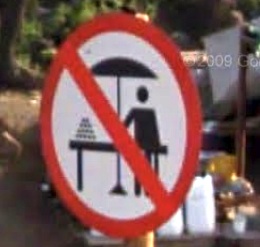Google Street View came to South Africa as part of the 2010 FIFA World Cup. It remains the only portion of continental Africa[1] with Street View coverage as of the time I posted this in February 2011. So it definitely provides opportunities to explore South Africa. However, it leaves me wanting for images of its neighbors.
One can spy only fleeting images from the South African side of the line. But this leaves a warped impression of other nations based upon artificial confluences at single points along the border.

This notion came to mind as I considered comments from a recent post made by loyal readers “Calgully” and “Peter.” We’d focused on South Africa’s border outside Lesotho’s capital of Maseru.
Lesotho
As Peter noted: “The Street View across the border in South Africa gives what may be a glimpse into Lesotho’s economy. There are about 25 minibuses lined up (including ones with the windshield slogans ‘Tears of Sadness’ and ‘Jealous – Down(?)’) apparently waiting for passengers. My guess is that they shuttle Maseru residents to jobs in South Africa, perhaps to the city of Bloemfontein more than 50 miles away.”
Is there a similar dynamic at work at South African border towns with other nations? Or perhaps it varies by location?
Eswatini (Swaziland)
Lesotho is positioned geographically in an unusual manner, a small enclave within South Africa completely surrounded on all sides. It shares no border with any other nation. Eswatini (formerly Swaziland) probably comes closer to a similar situation than many other African nations. It’s a small country like Lesotho. Nonetheless it does not quite qualify as an enclave. It finds itself sandwiched between South Africa and Mozambique.
One also finds a different situation at the border crossing here. A measure of commercial activity does concentrate at this boundary outpost. Somehow it seems quieter, less frenzied though. A large mural on a merchant’s wall implies a hearty welcome to South Africa from Coca Cola and the Oshoek Super Market & Take Away.
Mozambique
By contrast, abundant small-time vendor stalls line the roadside at a crossing with Mozambique. It seems considerably more vibrant and alive.

I also discovered what may be one of the most oddly specific road sign I’ve ever seen. It features a person, a table, a little pyramid of goodies, and best of all an umbrella. Unmistakably it prohibits the exact type of entrepreneurial activity that is taking place on all sides, complete with sundries, tables and umbrellas. It’s small-scale Capitalism at its finest.
Zimbabwe
This crossing at the Limpopo River into Zimbabwe seems to be a major international shipping route. It does have its share of locally-based vendors jockeying for position with a captive audience. In addition and more impressive however is the huge line of tractor-trailer trucks waiting to be cleared across the border. I also noticed large freight yards in satellite view as well as areas being used by automobile importers. This is very definitely a significant commercial transit point. It facilitates the movement of goods throughout the southeastern part of the continent.
Botswana
After all that activity and excitement we come to the border with Botswana. Very little seems to be happening here. The image shows a blockade but looks are deceiving. I found a sign nearby in Street View that identified this as the Skilpadshek Border Post. It also offered an explanation, “Upgrading of Essential Infrastructure – Construction of Main Border Post.” Nonetheless there isn’t much population density within the immediate vicinity, thus reducing entrepreneurial opportunities.
One other nation borders South Africa: Namibia. I found no Street View coverage in that quadrant, however.
In the next installment I’ll look at border crossings along another nation with interesting neighbors: Mexico.
12MC Loves Footnotes!
[1]The Canary Islands are generally considered a part of Africa and also have Google Street View coverage, thus the hair-splitting about “continental” Africa.

Leave a Reply